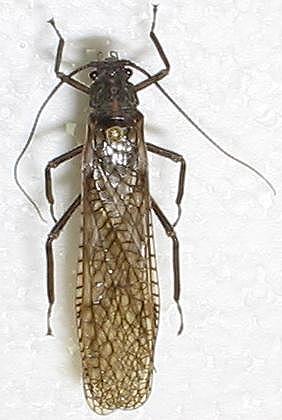- Plecoptera
__NOTOC__Taxobox
name = Stoneflies
fossil_range=Permian - Recent

image_caption = Adult of familyPteronarcyidae (Systellognatha )
image_width = 200px
regnum =Animal ia
phylum =Arthropod a
subphylum =Hexapoda
classis =Insect a
subclassis =Pterygota
infraclassis =Neoptera
superordo =Exopterygota
ordo = Plecoptera
ordo_authority = Burmeister, 1839
subdivision_ranks =Suborder s
subdivision =Arctoperlaria
and see textPlecoptera are an order of
insect s, commonly known as stoneflies. There are some 1,700 recordedspecies worldwide, and new ones continue toevolve . Stoneflies are believed to be one of the most primitive groups ofNeoptera , with close relatives identified from theCarboniferous and LowerPermian geological periods, while true stoneflies are known from fossils only a bit younger. The modern diversity however apparently is ofMesozoic origin. [Zwick (2000]Plecoptera are found in both the Southern and
Northern hemisphere s, and the populations are quite distinct although theevolution ary evidence suggests that species may have crossed the equator on a number of occasions before once again becoming geographically isolated [Hynes (1993), Zwick (2000] .All species of Plecoptera are intolerant of
water pollution and their presence in a stream or still water is usually an indicator of good or excellent water quality.Description and ecology
The name literally means "
braid ed-wings", from theAncient Greek "plekein" (πλέκειν, "to braid") and "pteryx" (πτέρυξ, "wing") [Woodhouse (1910)] . This refers to the complex venation of their two pairs of wings, which are membranous and fold flat over the back. Both nymphs and adults have long pairedcerci projecting from the tip of theirabdomen s.The nymphs are aquatic and live in the
benthic zone oflake s andstream s. Nymphs of this order are hunters of other aquatic arthropods or shredders of large organic particles, such as leaves. Some also graze on benthic algae. They undergo many molts as aquatic nymphs (10instar s?) before emerging and becoming terrestrial as adults.A few wingless species such as the
Lake Tahoe Benthic Stonefly (""Capnia" lacustra" [Thegenus "Capnia " is notmonophyletic and this species is suspected to belong elsewhere: Nelson (1996a)] ) or "Baikaloperla " are the only known insects that are exclusively aquatic from birth to death [Holst (2000)] . Sometrue water bug s (Nepomorpha) may also be fully aquatic for their entire life, but can leave the water to travel.ystematics
Traditionally, the stoneflies were divided into two
suborder s, the "Antarctoperlaria" (or "Archiperlaria") and theArctoperlaria . However, the former simply unites the two basalmostsuperfamilies , which do not seem to be each other's closest relatives however. Thus, the "Antarctoperlaria" are not conformed as a natural group (despite some claims to the contrary) and thus are not used here. [Nelson (1996b)]The Arctoperlaria, meanwhile, have been divided into two
infraorder s, theEuholognatha (orFilipalpia ) and theSystellognatha (aso calledSetipalpia orSubulipalpia ). This corresponds to thephylogeny , with one exception: theScopuridae must be considered a basal family in the Arctoperlaria, not assignable to any of the infraorders. Alternatively, the Scopuridae were placed in an unrankedclade "Holognatha" together with the Euholognatha (hence the name of the latter, meaning approximately "advanced Holognatha"). But the Scopuridae do not appear significantly closer to the Euholognatha than to the Systellognatha, and therefore the "Holognatha" are also not used here either. In addition, not adopting these two dubious "clades" allows for a systematic layout of the Plecoptera that adequately reproduces phylogeny, while retaining the familiar ranked taxa. [Nelson (1996b), Zwick (2000)][

Taeniopterygidae (Euholognatha )]
[
Perlidae (Systellognatha )] Basal lineages ("Antarctoperlaria")
* SuperfamilyEusthenioidea
** FamilyDiamphipnoidae
** FamilyEustheniidae
* SuperfamilyLeptoperloidea
** FamilyAustroperlidae
** FamilyGripopterygidae Suborder
Arctoperlaria
* Basal familyScopuridae
* InfraorderEuholognatha
** FamilyCapniidae (ca. 300 species) - small winter stoneflies
** FamilyLeuctridae - rolled-winged stoneflies
** FamilyNemouridae (ca. 400 species) - spring stoneflies
** FamilyNotonemouridae
** FamilyTaeniopterygidae (ca. 75 species) - winter stoneflies
* InfraorderSystellognatha
** FamilyChloroperlidae (100+ species) - green stoneflies
** FamilyPerlidae (ca. 400 species) - common stoneflies
** FamilyPerlodidae (250+ species)
** FamilyPeltoperlidae (ca. 50 species) - roachlike stoneflies
** FamilyStyloperlidae (ca. 7 species)
** FamilyPteronarcyidae (ca. 12 species) - salmonflies, giant stonefliesFootnotes
References
* (2000): Lake Tahoe benthic stonefly ("Capnia lacustra"). "In:" aut|Murhy, D.D. & Knopp, C.M.: " [http://www.fs.fed.us/psw/publications/documents/gtr-175/ Lake Tahoe Watershed Assessment] ": O-118 – O-120. USDA. [http://www.fs.fed.us/psw/publications/documents/gtr-175/gtr-175-appendixO.pdf PDF fulltext]
* (1993): "Adults and Nymphs of British Stoneflies".Freshwater Biological Association . ISBN 0-900386-28-2
* (1996a):Tree of Life Web Project - [http://tolweb.org/Capniidae/13943/1996.01.01 Capniidae. Winter Stoneflies] . Version of 1996-JAN-01. Retrieved 2008-JUL-31.
* (1996b):Tree of Life Web Project - [http://tolweb.org/Plecoptera/8245/1996.01.01 Plecoptera. Stoneflies] . Version of 1996-JAN-01. Retrieved 2008-JUL-31.
* (1910): English-Greek Dictionary - A Vocabulary of the Attic Language. George Routledge & Sons Ltd., Broadway House, Ludgate Hill, E.C. [http://www.lib.uchicago.edu/efts/Woodhouse/ Searchable JPEG fulltext]
* (2000): Phylogenetic System and Zoogeography of the Plecoptera. "Annu. Rev. Entomol." 45: 709-746. doi|10.1146/annurev.ento.45.1.709 (HTML abstract)
Wikimedia Foundation. 2010.
